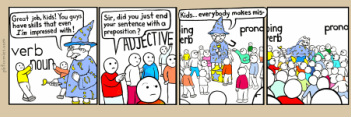What is syntax?

When you preview text with your students, do you point out different sentence structures or patterns, to help get them ready to read and access the material? Well, you are helping them with learning about syntax- the grammatical and structural basics of English. Syntax helps us to make clear sentences that “sound right,” where words, phrases, and clauses each serve their function and are correctly ordered to form and communicate a complete sentence with meaning. The parts of speech are groups of words that make up the grammar of the English language, which include open-class words (changeable and accepts new words, such as nouns, adjectives, verbs, and adverbs) and closed-class words (function words and rarely accepts new words, such as prepositions, conjunctions, pronouns, complementizers, determiners, and auxiliary verbs). In these categories, words can be described by their morphological forms and typical position in a sentence. The following website “Parts of Speech” by Heather MacFadyen offers a detailed explanation and review of the different parts of speech and how they are used in sentences: http://www.arts.uottawa.ca/writcent/hypergrammar/partsp.html. Next, we must look at grammar at the phrase, clause, and sentence level. Constituents are groups of words that go together and fit into larger units, which are then built into sentences. Let’s look at the following sentence: The happy boy jumped swiftly over the rock by the pond. The smaller constituents (i.e. the happy boy, the pond, the rock- all noun phrases) fit into larger constituents (i.e. by the pond- prepositional phrase), and even larger constituents (the rock by the pond- bigger noun phrase). These constituents follow a hierarchical structure: Word --> Phrase --> Clause --> Sentence In English, the 5 types of phrases include: noun phrases, verb phrases, adjective phrases, adverb phrases, and prepositional phrases. Clauses are composed of noun phrases as the subject and verb phrases as the predicate. Some clauses can stand independently as a sentence, and others are dependent or subordinate. Compound sentences can be formed by joining two independent clauses, joined by a conjunction or punctuation (semicolon or colon). To learn more about phrases, clauses, and sentence structure rules, you can look at this section on MacFayden’s website on parts of a sentence: http://www.arts.uottawa.ca/writcent/hypergrammar/partse.html |
In the classroom
Tips for Applying Syntax:
|
